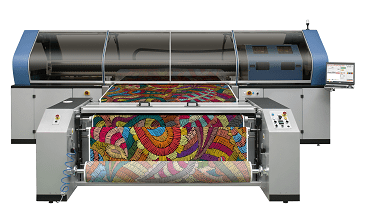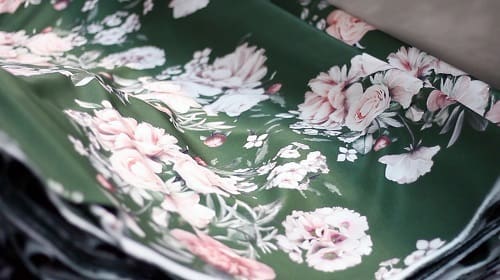- Investments in sublimation textile printing solutions from Mimaki led the Polish company to rapidly enhance its business and diversify its product portfolio, as well as addressing textile market segments
- Cutting-edge technology, combined with outstanding print quality and a reliable and efficient after-sales service are some of the features that led Colourama to choose Mimaki as a long-established technology partner
Polish textile printer Colourama specialises in heat transfer paper printing and addresses the fashion and apparel, home décor and contract textile markets. Based in Łódź, also known as the “Polish Manchester”, at the heart of a fashion and textile trade district, the company has experienced rapid growth over recent years. With a boosted production capacity and a diversified range of textile printing applications, Colourama has succeeded in becoming a major player in the textile arena, serving the Polish national market, as well as other European markets. Three key factors fuelled such a quick expansion: the shift from conventional to digital textile printing, the choice of Mimaki as a long-established technological partner, and an in-house design studio directly connected to the production facility.
Colourama was founded in 2005. The business was originally centred around conventional textile printing and part of the production was outsourced to China. In 2011 the management decided to move to digital textile printing. “When we planned to shift from conventional to digital printing, we also opted for taking production in-house, in order to cut costs and optimise the production process,” says Robert Steijn, founder and managing director at Colourama. “As a first step, we invested in six digital textile printers from a Chinese brand, but after one year we were already experiencing capacity shortage. Therefore, we turned to Mimaki’s technology.”
The move proved to be a milestone in the company’s history. Colourama initially purchased ten Mimaki JV5 printing systems and after a few months added ten additional printers from Mimaki, almost completely replacing the conventional production equipment. “We immediately took full advantage of digital sublimation printing. The production costs dropped down and we were able to overcome all the limits in creativity, in terms of colours, colour variations, repeats and size. In one word, we boosted to almost unlimited possibilities in design, which enabled us to diversify the product portfolio and address new market segments.”
Following both revenue and demand increases, in 2014 Colourama was once again in need of a boost to production capacity, which led to the purchase of 13 highly productive Mimaki TS500-1800 presses and to the renovation of existing printing equipment. This resulted in the company having a total of 23 Mimaki printers in 2015, namely 13 TS500-1800 units and 10 JV5 units, which raised the monthly production capacity up to 350,000-to-375,000 linear meters. “While in the process of identifying a high-end printing unit that could fit our production needs, we got in touch with different technology providers. However, we heard from other printing companies about after-sales service. And when you address the fast fashion and home décor segments, time-to-market in crucial, which means that your printers should run 24/7 and you can’t afford downtime. Therefore, we stuck to Mimaki,” states Steijn.
Innovation has continued to drive the business growth up to today at Colourama. With the in-house design studio developing outstanding creative patterns and designs, the company has recently invested in further cutting-edge technologies from Mimaki; namely, one TS500-1800, one TS500P-3200 (plus two additional systems yet to be delivered), two Tiger-1800B and one Tiger-1800B MkII have been added to the company’s printing equipment. “The Tiger-1800B units have enabled us to cope with the high requirements of the fashion industry in terms of both short delivery time and high-quality standards. The sticky belt system together with the lighter-weight paper and the use of jumbo reels (that allow a feeding capacity of 10,000 to 15,000 meters and longer unattended printing) are some of the features that make this printer efficient, user-friendly and stable. Also, we have been able to deal with the competitive pricing in fashion, as the Tiger equipment is cost-effective, with affordable prices for the inks.” All the Tiger-1800B units installed at Colourama’s production facility have already been updated to the MkII version. “There are several new features on the Tiger-1800B MkII that will bring benefits to our production and to our business. The MAPS, just to name one, will provide higher speed with higher standard quality.”
Colourama has been a pioneer in adopting Mimaki’s latest technologies. Being one of the first companies to install the new Tiger printing technology, it experienced some hiccups during the implementation process. However, the management says they never lost trust in Mimaki and in Teba – Mimaki’s local distributor: “Both Teba and Mimaki were always there to solve any critical situations. We had people from the R&D department of Mimaki Japan who spent almost two months at our facility to monitor the implementation process and to help sort out all the issues, which has been very helpful.”
“The reason for choosing Mimaki back in 2011 was related to our trust in its local service dealer, Teba. I had had the chance to work with them before and was aware of the quality and reliability of the service and assistance they provided, which is crucial in the textile printing environment,” Steijn states. “Over the past years of partnership, we have kept experiencing a fantastic service from Teba and Mimaki, which has been crucial to build our trust in both the companies and to enable us to succeed in establishing Colourama as a leader in the textile printing industry, So, yes! You can definitively say that I am in love with Mimaki,” Steijn concludes.
For more information about products and services from Mimaki, visit www.mimakieurope.com.
— END —




